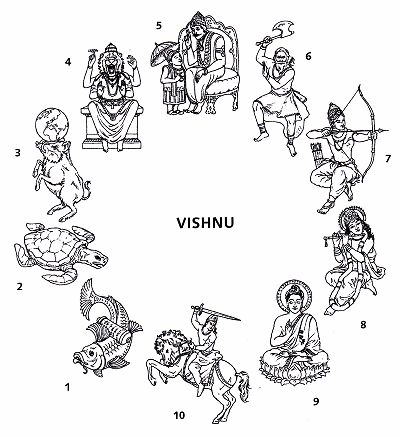
The story:
‘Until quite recently’ a statue of a horse and warrior – figures
from Hindu mythology – stood outside a tiny village in
India. For a long time the statue was neglected and ignored,
but one day it ‘changes hands’.
Muni, an old man who is minding his two goats near
the statue, encounters an American tourist interested in all
things Indian who wants to buy the statue and thinks Muni
is in a position to sell it. Unfortunately, Muni understands
no English whatsoever. First, he thinks the tourist might be
a government official investigating a murder, but then he
perceives his interest in the statue and launches into a
lengthy narrative based on Hindu mythology. The
American’s attempts to make Muni realize that he is only
interested in buying the statue come to nothing, but when
he strokes the old man’s goats in an attempt to be friendly,
Muni becomes convinced that the man wants to buy his
animals. Delighted, he takes the money the American offers
him and wanders off. The tourist is left standing by the
statue, assuming that Muni has gone to find someone to
help him get the statue into the car.
What we learn about …
… Hindu mythology
In spite of the fact that Muni could be considered a social
outcast with no education, he does have a good knowledge
of the Hindu epics Ramayana and Mahabharata. These
epics have been passed on from generation to generation
in the form of oral narratives, thus giving him a sense of
identity within the framework of his native oral history.
… Misunderstandings and misconceptions
When reading ‘A Horse and Two Goats’, there may be the
temptation to classify the story as a clash of cultures: East
vs. West, materialism vs. spiritualism, poverty vs. wealth.
The term ‘clash’, however denotes an action between two
conflicting parties, the outcome of which is usually, at
least for one of the parties, negative. In this case, the
‘clash’ is only in the consciousness of the reader, as neither
of the two protagonists perceive the other as an opponent.
As a consequence, no-one suffers, there is no loser and at
the end of the story each party seems to have got what
they wanted. One could even conclude that ‘A Horse and
Two Goats’ is not about a clash of cultures. In that case
the question arises how it is to be read. Perhaps it would
be more in line with Narayan’s intention to read it as a
simple ‘comedy of errors’. A reading of this kind would
by no means disqualify the story from the anthology or
make it irrelevant to a study of post-colonial literature.
On the contrary, one could even go as far as to say that in
a globalized world the narrative is perhaps even more
relevant than ever, as it illustrates the difference in world
views: on the one hand, the ancient world picture, on the
other hand, the modern consumer mentality. Errors
arising from ignorance and cultural superiority in a world
of shrinking distances and easy connections may have
more fatal consequences than the transformation of an
object of religious veneration into a tourist souvenir.

About the author:
 R. K. Narayan was born into a middle-class Brahmin family in
1906. He grew up in a suburb of Madras, and as a young man
took up teaching, but without much success or joy. His decision
to earn a living as a writer was met with discouragement as he
could not find a publisher, let alone a readership, and his family
did not take his efforts seriously. However, the renowned British
writer Graham Greene recognised his talent and helped to get
his work published in Britain.
Narayan is a traditional teller of tales, preferring to be gentle
and humorous rather than hard-hitting. His irony is rooted in
a Hindu view of the world, in which the conflicts and
contradictions of everyday life are no more than minor events in
the face of an established cosmic order. This simplicity has led
to his being regarded as an anecdote-teller or a small-town
ironist who presents the human comedy without philosophical
implications. On the other hand, Narayan has also been called
India’s most accomplished author and one of the most admired
writers in English.
R. K. Narayan was born into a middle-class Brahmin family in
1906. He grew up in a suburb of Madras, and as a young man
took up teaching, but without much success or joy. His decision
to earn a living as a writer was met with discouragement as he
could not find a publisher, let alone a readership, and his family
did not take his efforts seriously. However, the renowned British
writer Graham Greene recognised his talent and helped to get
his work published in Britain.
Narayan is a traditional teller of tales, preferring to be gentle
and humorous rather than hard-hitting. His irony is rooted in
a Hindu view of the world, in which the conflicts and
contradictions of everyday life are no more than minor events in
the face of an established cosmic order. This simplicity has led
to his being regarded as an anecdote-teller or a small-town
ironist who presents the human comedy without philosophical
implications. On the other hand, Narayan has also been called
India’s most accomplished author and one of the most admired
writers in English.
For more look here!
zurück zur Übersicht
|


 R. K. Narayan was born into a middle-class Brahmin family in
1906. He grew up in a suburb of Madras, and as a young man
took up teaching, but without much success or joy. His decision
to earn a living as a writer was met with discouragement as he
could not find a publisher, let alone a readership, and his family
did not take his efforts seriously. However, the renowned British
writer Graham Greene recognised his talent and helped to get
his work published in Britain.
Narayan is a traditional teller of tales, preferring to be gentle
and humorous rather than hard-hitting. His irony is rooted in
a Hindu view of the world, in which the conflicts and
contradictions of everyday life are no more than minor events in
the face of an established cosmic order. This simplicity has led
to his being regarded as an anecdote-teller or a small-town
ironist who presents the human comedy without philosophical
implications. On the other hand, Narayan has also been called
India’s most accomplished author and one of the most admired
writers in English.
R. K. Narayan was born into a middle-class Brahmin family in
1906. He grew up in a suburb of Madras, and as a young man
took up teaching, but without much success or joy. His decision
to earn a living as a writer was met with discouragement as he
could not find a publisher, let alone a readership, and his family
did not take his efforts seriously. However, the renowned British
writer Graham Greene recognised his talent and helped to get
his work published in Britain.
Narayan is a traditional teller of tales, preferring to be gentle
and humorous rather than hard-hitting. His irony is rooted in
a Hindu view of the world, in which the conflicts and
contradictions of everyday life are no more than minor events in
the face of an established cosmic order. This simplicity has led
to his being regarded as an anecdote-teller or a small-town
ironist who presents the human comedy without philosophical
implications. On the other hand, Narayan has also been called
India’s most accomplished author and one of the most admired
writers in English.